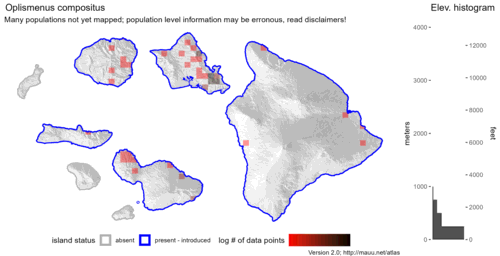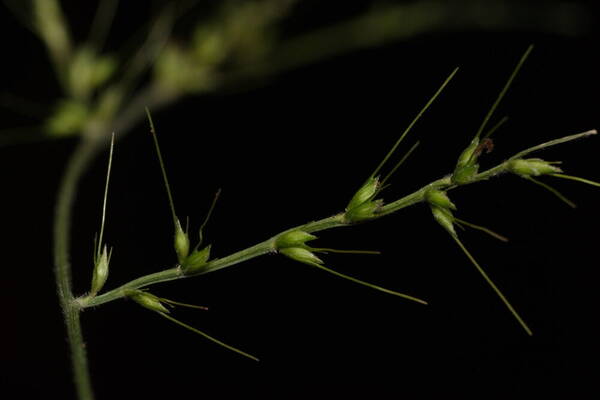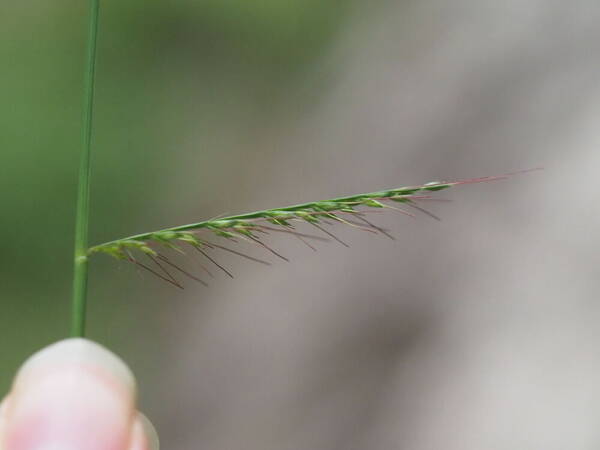Info
Subfamily: Panicoideae
Genus etymology: Oplismenus = "armed" [Greek] refering to the long awns of the glumes
Species etymology: compositus = "compound" [Latin] refering to the inflorescence
Photosynthetic type: C3 (cool season)
Nativity: naturalized - accidental
First recorded in Hawaiʻi: 1902
Map


Inflorescence



Habit


Spikelets




Description
Perennial with rambling culms 15–150 cm. long. Leaf-blades narrowly lanceolate to narrowly ovate, 2–15 cm. long, 8–25 mm. wide. Inflorescence 5–25 cm. long, the lower raceme 2.5–11 cm. long, its rhachis glabrous to loosely pilose, the spikelet pairs ± distant. Spikelets lanceolate, 2.5–4 mm. long, glabrous to pubescent; glumes with smooth viscid awns, the longest in each pair of spikelets 3–10 mm. Fig. 129.
(Description source: Clayton, W.D. & Renvoize, S.A. 1982. Flora of Tropical East Africa. Gramineae (Part 3). A.A. Balkema, Rotterdam. 448 pp. )
Rambling perennial with lanceolate to narrowly ovate leaf laminae. Culms 15–150 cm. long. Racemes up to 11 cm. long, the spikelet pairs distant. Spikelets 2.5–4 mm. long, glabrous to pubescent; awns smooth and sticky, the longest in each pair of spikelets 3–10 mm.
(Description source: Launert, E. & Pope, G.V. (eds.). 1989. Flora Zambesiaca. Volume 10. Part 3. Kew, London. 152 pp. )
Inflorescence composed of racemes. Racemes 4-12; borne along a central axis; unilateral; 2.5-11 cm long (lowest). Central inflorescence axis 5-25 cm long. Rhachis angular; glabrous on surface, or pilose on surface. Spikelet packing lax; regular; 2 -rowed. Spikelets in pairs. Fertile spikelets sessile and pedicelled; 2 in the cluster; subequal, or the lower smaller. Pedicels oblong. Spikelets: Spikelets comprising 1 basal sterile florets; 1 fertile florets; without rhachilla extension. Spikelets lanceolate; laterally compressed; 2.5-4 mm long; falling entire. Fertile Spikelets: Spikelets comprising 1 basal sterile florets; 1 fertile florets; without rhachilla extension. Spikelets lanceolate; laterally compressed; 2.5-4 mm long; falling entire. Glumes: Glumes similar, or dissimilar; shorter than spikelet; thinner than fertile lemma. Lower glume ovate; 1 length of upper glume; 0.5-0.75 length of spikelet; herbaceous; 1-keeled; 5 -veined. Lower glume surface glabrous, or pubescent. Lower glume apex acute; awned; 1 -awned. Lower glume awn 3-10 mm long; viscid. Upper glume ovate; herbaceous; 1-keeled; 5-7 -veined. Upper glume surface glabrous, or pubescent. Upper glume apex obtuse; muticous, or awned. Upper glume awn 0-4 mm long. Florets: Basal sterile florets barren; with palea, or without significant palea. Lemma of lower sterile floret ovate; 1 length of spikelet; membranous; 1-keeled; 7-11 -veined; glabrous, or pubescent; emarginate; mucronate. Fertile lemma oblong; dorsally compressed; 2-2.5 mm long; coriaceous; shiny; without keel; 7 -veined. Lemma margins involute. Lemma apex acute; laterally pinched. Palea involute; coriaceous; without keels. Fruits: Hilum linear; 0.5 length of caryopsis. Distribution: Africa: northeast tropical, east tropical, southern tropical, south, and western Indian ocean. Asia-temperate: western Asia, Arabia, China, and eastern Asia. Asia-tropical: India, Indo-China, Malesia, and Papuasia. Australasia: Australia. Pacific: southwestern, south-central, northwestern, and north-central. North America: Mexico. South America: Mesoamericana, northern South America, and western South America.
(Description source: Clayton, W.D., Vorontsova, M.S., Harman, K.T. and Williamson, H. (2006 onwards). GrassBase - The Online World Grass Flora. Available at https://powo.science.kew.org )
Perennials; culms sprawling, 1.5-15 dm long, appressed pubescent. Sheaths loosely clasping the culm, usually 3-6 mm long, shorter than the internode, glabrous to pubescent, margins ciliate, apex densely pubescent; ligule ca. 1 mm long, membranous, apex truncate, erose, with hispid setae up to 1 mm long; blades narrowly lanceolate to narrowly ovate, 2-15 cm long, 8- 25 mm wide, scabrous, sparsely papillose hispid. Racemes ascending to spreading, 5-25 cm long, the lowermost raceme 2.5-11 cm long, rachis puberulent and very sparsely papillose-pilose, adjacent spikelet pairs on lower racemes 4-12 mm apart; spikelets lanceolate, 2.5-4 mm long, glabrous to pubescent; glumes puberulent and ciliate on margins, first glume ovate, 2-3.5 mm long, strongly 5-nerved, apex prolonged into a well-developed, smooth, viscid awn 5-15 mm long, second glume similar to first glume but with an awn 1-3 mm long; first lemma similar to second glume, margins folded around second floret, apex with an awn 0.5-1 mm long; first palea occasionally present, hyaline; second lemma coriaceous, ovoid, ca. 2.5 mm long, glabrous, glossy, margins enclosing palea, apex acute; second palea ovate to lanceolate, 2-2.5 mm long, glabrous, glossy, margins inrolled, apex acute. Caryopsis broadly ellipsoid, 2.5-3 mm long. [2n = 18, 40, 54, 72.]
(Description source: O’Connor, P.J. 1990. Poaceae, pp. 1481–1604. In: Wagner W.L., Herbst D.R. & Sohmer S.H. (eds.)., Manual of the flowering plant of Hawaiʻi. Vol. 2. University of Hawaii Press & Bishop Museum Press, Honolulu )